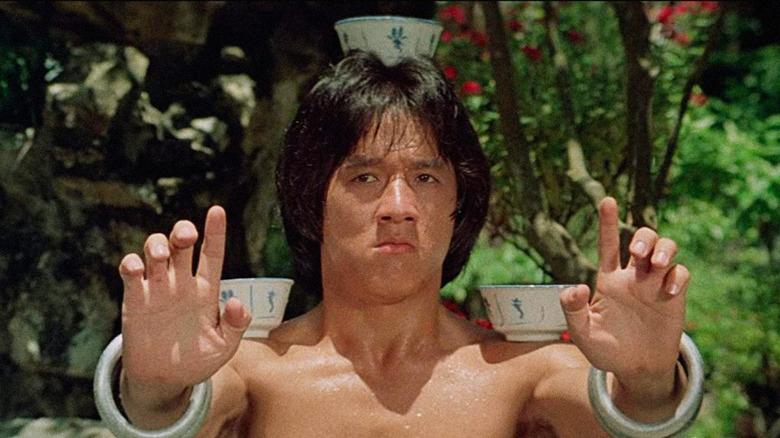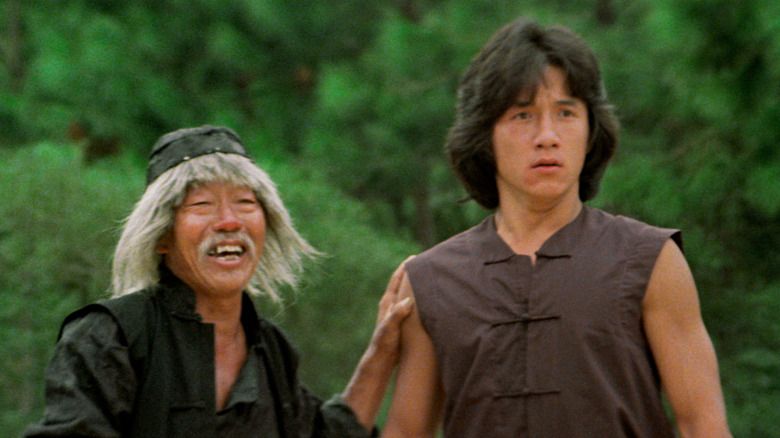
It's hard to imagine a time before Jackie Chan was a certified action star, but in the early 70s, his international (and especially domestic) success was far from a sure thing. Hong Kong's film industry floundered for years after the untimely death of Bruce Lee, and for years the industry tried and failed to fill the void that Lee had left behind. Chan, a former stuntman who'd appeared in some of Lee's best work, was one such contender. He worked on several films with Lo Wei, (the mind behind classic Bruce Lee films like "The Big Boss" and "Fist of Fury") who tried to conform the fledgling star to Lee's own image. But it wasn't until Chan first partnered with director Yeun Woo-ping in "Snake in the Eagle's Shadow" that his trademark comedic style would begin to take shape.
Chan continued to hone that style in the Yeun-directed "Drunken Master." The 1978 film follows the cheeky know-it-all son of a martial arts master who, after a string of messy antics, is sent to study with his sadistic (and alcoholic) uncle. He eventually learns discipline, as well as an eccentric form of martial arts called The Eight Drunken Immortals. Not only did the film catapult Chan to stardom in Asia, but it was also one of the first films to successfully meld martial arts and comedy.
Perhaps most notably, "Drunken Master" had a hand in popularizing Drunken Boxing, a blanket term for martial arts styles that adopt "drunken" movements into the choreography. The Drunken Boxing on display in "Drunken Master" was actually created by Chan and Yeun. Apart from directing a number of films, Yeun is also a renowned fight choreographer in his own right, responsible for shaping the action of films like "Crouching Tiger, Hidden Dragon" and "The Matrix." But for Chan, it wasn't enough to simply choreograph a realistically-"drunk" fighting style. He had to embody it as best he could, and he went to heady lengths to do so.
An Intoxicating Commitment

After nearly 60 years in film, Chan has become notorious for his commitment to his stunts, in many cases flouting his well-being to achieve the best results possible. It was no different for "Drunken Master." Chan recalled workshopping the choreography in the midst of production to the South China Post in 1998. Chan said, "When everyone was sleeping after shooting, I would go home and try things out in front of the mirror."
Chan would spend hours "just doing drunken things," searching for something that would give a real edge to the fighting style. "I kept thinking, how can I fight properly and look like I am drunk?" Chan admits that achieving the drunken final product was "difficult," but not impossible. Eventually, he found a solution that would translate to drunkenness on-camera:
I held my breath when I was punching – that made me feel very dizzy, like I was drunk ... That was tough to do, and I did it every day for three months. One day I held my breath for too long and fell over. I had to do it for more than one take, remember – the fighting scenes need 20 takes or 30 takes.
Chan's commitment obviously paid off in a major way. Not only did "Drunken Master" pave the way for a number of spin-offs (official or otherwise), but it cemented Chan as a certified action star in his own right, one whose style would not be contained under the shadow of Bruce Lee. "Drunken Master" is a perfect example of what can happen when risks are taken in film, even if Hong Kong's film industry did try to recreate the success of kung fu comedy soon after its release.
Read this next: The 15 Best Jackie Chan Movies Ranked
The post Jackie Chan Went To Dizzying Lengths To Perfect His Drunken Master Style appeared first on /Film.
0 Comments